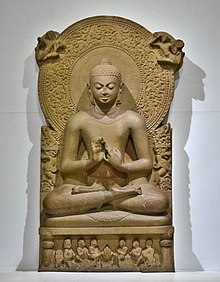 Gautama Buddha (c. 563 BCE/480 BCE – c. 483 BCE/400 BCE), also known as Siddhārtha Gautama, Shakyamuni Buddha,[4] or simply the Buddha, after the title of Buddha, was an ascetic (śramaṇa) and sage,[4] on whose teachings Buddhism was founded.[5] He is believed to have lived and taught mostly in the eastern part of ancient India sometime between the sixth and fourth centuries BCE.[6][note 3]
Gautama Buddha (c. 563 BCE/480 BCE – c. 483 BCE/400 BCE), also known as Siddhārtha Gautama, Shakyamuni Buddha,[4] or simply the Buddha, after the title of Buddha, was an ascetic (śramaṇa) and sage,[4] on whose teachings Buddhism was founded.[5] He is believed to have lived and taught mostly in the eastern part of ancient India sometime between the sixth and fourth centuries BCE.[6][note 3]
Gautama taught a Middle Way between sensual indulgence and the severe asceticism found in the śramaṇa movement[7] common in his region. He later taught throughout other regions of eastern India such as Magadha and Kosala.[6][8]
Gautama is the primary figure in Buddhism. He is recognized by Buddhists as an enlightened teacher who attained full Buddhahood, and shared his insights to help sentient beings end rebirth and suffering. Accounts of his life, discourses, and monastic rules are believed by Buddhists to have been summarized after his death and memorized by his followers. Various collections of teachings attributed to him were passed down by oral tradition and first committed to writing about 400 years later.
Buddhism (pronunciation: /ˈbʊdɪzəm/ or /ˈbuːdɪzəm/)[1][2] is a religion[3][4] and dharma that encompasses a variety of traditions, beliefs and spiritual practices largely based on teachings attributed to the Buddha. Buddhism originated in India sometime between the 6th and 4th centuries BCE, from where it spread through much of Asia, whereafter it declined in India during the middle ages. Two major extant branches of Buddhism are generally recognized by scholars: Theravada (Pali: "The School of the Elders") and Mahayana (Sanskrit: "The Great Vehicle"). Buddhism is the world's fourth-largest religion, with over 500 million followers or 7% of the global population, known as Buddhists.[web 1][5]
Buddhist schools vary on the exact nature of the path to liberation, the importance and canonicity of various teachings and scriptures, and especially their respective practices.[6][7] Practices of Buddhism include taking refuge in the Buddha, the Dharma and the Sangha, study of scriptures, observance of moral precepts, renunciation of craving and attachment, the practice of meditation (including calm and insight), the cultivation of wisdom, loving-kindness and compassion, the Mahayana practice of bodhicitta and the Vajrayana practices of generation stage and completion stage.
In Theravada the ultimate goal is the attainment of the sublime state of Nirvana, achieved by practicing the Noble Eightfold Path (also known as the Middle Way), thus escaping what is seen as a cycle of suffering and rebirth.[8] Theravada has a widespread following in Sri Lanka and Southeast Asia.
Mahayana, which includes the traditions of Pure Land, Zen, Nichiren Buddhism, Shingon and Tiantai (Tendai), is found throughout East Asia. Rather than Nirvana, Mahayana instead aspires to Buddhahood via the bodhisattva path,[10] a state wherein one remains in the cycle of rebirth to help other beings reach awakening. Vajrayana, a body of teachings attributed to Indian siddhas, may be viewed as a third branch or merely a part of Mahayana. Tibetan Buddhism, which preserves the Vajrayana teachings of eighth century India,[11] is practiced in regions surrounding the Himalayas, Mongolia[12] and Kalmykia.[13] Tibetan Buddhism aspires to Buddhahood or rainbow body.[14]
No comments:
Post a Comment